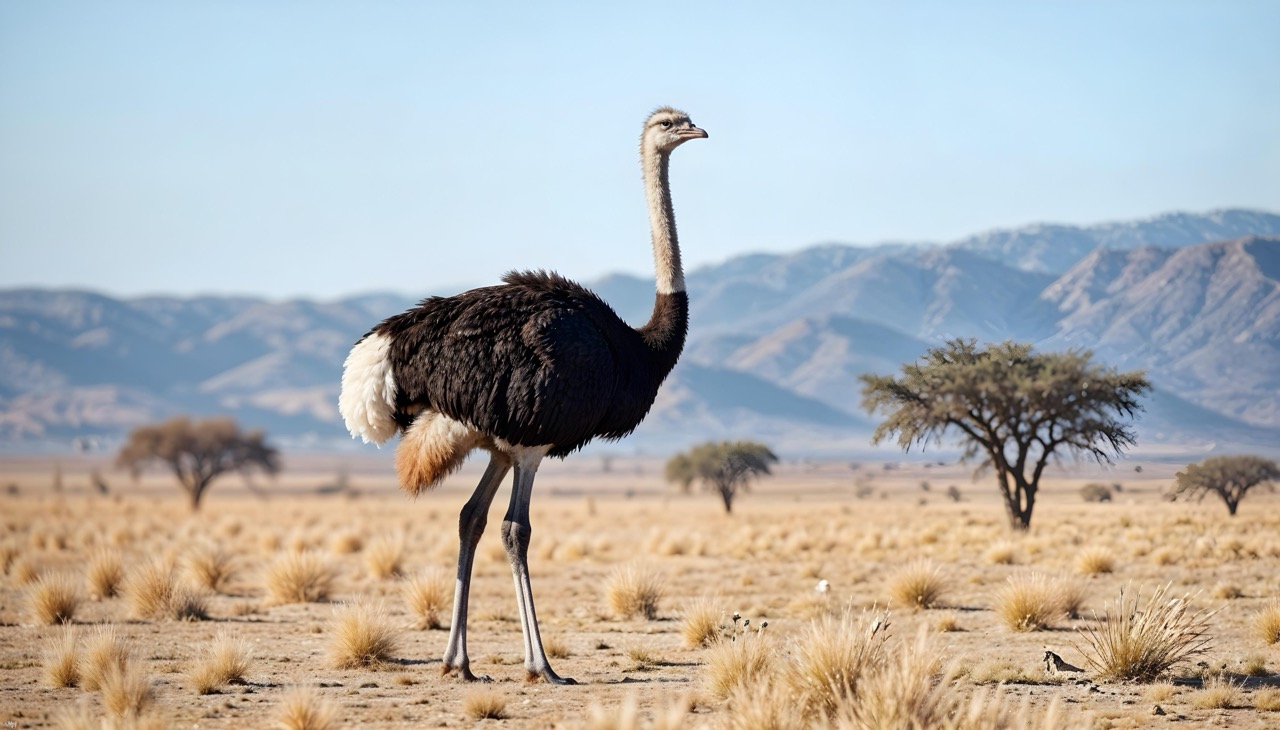The ostrich, with its long neck and powerful legs, stands as a symbol of both curiosity and might in the vast landscapes of Africa. Known as the world’s largest bird, the ostrich is a marvel of evolutionary adaptation, perfectly equipped to thrive in some of the planet’s harshest environments. This article delves into the fascinating world of the ostrich, exploring its unique characteristics, behavior, and the role it plays in its ecosystem.
Characteristics / Physical Description
The ostrich is distinguished by its impressive size, standing up to 9 feet tall and weighing as much as 140 kilograms, making it the largest bird on Earth. Despite being flightless, its wings play crucial roles in mating displays, shade for chicks, and balance when running. The bird’s most notable feature is its long, powerful legs, capable of reaching speeds up to 70 km/h, making it the fastest two-legged animal in the world. Ostriches have two toes on each foot, unlike other birds, which helps them move efficiently on soft sand and firm soil alike.
Taxonomy and Classification
Scientifically known as Struthio camelus, the ostrich belongs to the order Struthioniformes and the family Struthionidae. The species is further divided into several subspecies, adapted to various geographic regions across Africa. This diversity reflects the ostrich’s ability to inhabit a range of environments from savannas to deserts.
Behavior and Social Structure
Ostriches are highly social birds, often found in groups that can number up to 50 individuals, depending on the season and habitat conditions. These groups are typically led by a dominant male and female. The social structure is complex, with males establishing territories that they defend vigorously during the breeding season. Ostriches communicate through a series of calls, hisses, and physical displays.
Habitat and Distribution
The ostrich inhabits a range of environments from the sandy deserts to savannahs and the open woodlands of Africa. Their distribution spans from the Sahel region to South Africa, where they adjust to the extreme conditions through behavioral and physiological adaptations.
Diet and Feeding Habits
Ostriches are omnivores, consuming a diet that includes seeds, shrubs, grass, fruits, and insects. Their long necks are advantageous for foraging on the ground and their height aids in spotting potential predators from a distance. Interestingly, ostriches also ingest small stones and pebbles which help in grinding up food within their gizzard—a muscular part of the stomach.
Breeding and Reproduction
Ostriches have a unique breeding system. The dominant male mates with the dominant female as well as several others in the group. The female lays her eggs in a communal nest, which is a simple pit scraped in the ground by the male. This nest can contain more than 50 eggs at a time, although not all typically belong to the dominant female. Eggs are incubated primarily by the dominant male and female, who take turns, particularly at night when predation risk is higher.
Relationship with Humans
Historically, ostriches have been hunted and farmed extensively for their feathers, skin, and meat. Today, ostrich farming is a significant agricultural practice in some parts of the world, particularly in South Africa. Ostrich races and other tourist attractions also utilize these birds, often sparking controversy from animal rights groups.
Evolutionary History
The ostrich is the last living species of its family, which once included several different types all adapted to life on the open land. Fossil records suggest that these birds once roamed across Asia and Africa, adapting over millions of years to a flightless lifestyle due to their large size and the lack of natural predators.
Use as Research Animals
Ostriches are occasionally used in scientific research due to their unique physiology and resistance to diseases. Studies often focus on their cardiovascular and respiratory efficiency, providing insights that are relevant not only to avian science but also to understanding evolutionary adaptations in a range of species.
The ostrich, with its grand stature and unique adaptations, is more than just a bird; it is a testament to the wonders of natural evolution and adaptation. As we continue to explore and understand these magnificent creatures, we uncover more about the complexity of life on Earth and the myriad ways species adapt to their environments.

